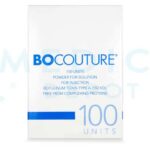

Botox, the brand name for botulinum toxin type A, has gained widespread recognition in both medical and cosmetic fields for its diverse applications. It is a versatile medication used for therapeutic and aesthetic purposes. This article delves into the world of Botox, revealing its mechanisms of action, analyzing its diverse applications, and addressing frequently asked questions, such as “How long does Botox last?”
We will explore the optimal frequency of Botox treatments, considering individual responses and the value of personalized treatment plans for both therapeutic and cosmetic goals.
Last, we will highlight the significance of Botox maintenance and aftercare to optimize treatment outcomes.
What is Botox?
Botox is the brand name for the medication, botulinum toxin type A. It’s a neurotoxic protein produced by the bacterium Clostridium botulinum and used in medicine for therapeutic and cosmetic purposes.
Botox is administered in small and controlled doses in medical applications to temporarily paralyze or weaken muscles. It can be used to treat various conditions, including:
- Muscle spasms and dystonia;
- Chronic migraines;
- Overactive bladder.
In cosmetology, botulinum toxin preparations are used to correct expression lines and treat localized forms of hyperhidrosis. Mimic wrinkles are created by repeated muscle activity, mostly located on the upper third of the face.
Unlike the upper third of the face, static wrinkles dominate the lower two-thirds of the face. Genetic factors, age-related atrophy of subcutaneous fatty tissue, gravitational ptosis, photo-aging of the skin, and, to a lesser extent, the activity of mimic muscles cause their formation.
Botulinum toxin acts only on the muscles, so the fewer muscles involved in forming a particular wrinkle, the lesser the drug’s effect.
How Does it Work?
Botox temporarily interferes with the communication between nerves and muscles. When injected in small doses, Botox blocks acetylcholine release at the neuromuscular junction, preventing nerve signal transmission and leading to muscle paralysis or weakening.
We can outline the process by which Botox works as follows:
- Nerve-muscle communication
At the neuromuscular junction, nerve endings release acetylcholine, a chemical messenger. Acetylcholine binds to receptors on the muscle, leading to muscle contraction.
- Injection
Botox preparation is injected into specific muscles using a fine needle. The choice of injection sites depends on the condition being treated, whether for cosmetic purposes or therapeutic applications.
- Acetylcholine blockade
Botox interferes with this process by preventing the release of acetylcholine from the nerve endings. This blockade inhibits the communication between nerves and muscles, temporarily relaxing or weakening the targeted muscles.
- Muscle relaxation
With reduced or blocked nerve signals, the muscle cannot contract fully. As a result, the muscle relaxes, leading to a reduction in muscle movement and function.
So what effect can doctors achieve by injecting botulinum toxin?
Therapeutic effects: In therapeutic applications, such as treating muscle spasms or certain medical conditions, the muscle relaxation provided by Botox helps alleviate symptoms and improve the patient’s quality of life.
- Cosmetic effects: In cosmetic applications, Botox is used to relax the facial muscles, reducing wrinkles. It leads to a smoother, more youthful appearance.
It’s important to note that the effects of Botox are temporary, typically lasting for a few months. As the nerve endings regenerate and acetylcholine release resumes, muscle function gradually returns to normal, requiring repeat treatments if the patient wishes to maintain the effects of Botox.
How Long Does Botox Last?
The medication blocks nerve impulse transmission to the muscle, preventing it from contracting. Over time, this effect subsides as the pathway of impulse transmission is restored. The effect of Botox lasts approximately 4-6 months and depends on the physiological characteristics of the body. However, the Botox timeline may be different for patients with an active lifestyle and a fast metabolism, resulting in a quicker wearing-off of the effects.
How Often Can You Get Botox?
For cosmetic purposes, the effects of Botox and Korean botox are temporary and typically last around 3 to 6 months. As the muscle activity gradually returns, the wrinkles may become more noticeable again.
The recommended frequency for cosmetic Botox injections is typically every three to four months to maintain the desired results. However, some patients may have more prolonged effects and receive treatments less frequently.
Botox Maintenance and Aftercare
The main aftercare recommendations are:
- Remain in an upright position for 3-4 hours after the treatment;
- Do not massage the injection area;
- Cool the injection site (apply ice) for 15-20 minutes;
- Perform muscle movements in the injected area for 30 minutes after the procedure;
- Avoid hot temperatures around the injection area, including jacuzzis and saunas, for one to two weeks;
- Limit alcohol consumption for at least two weeks.
Doctors usually provide more detailed, written recommendations on maintaining the longevity of Botox treatment after the procedure.
Conclusion
In conclusion, Botox, derived from botulinum toxin type A, has become a versatile and widely used medication in medical and cosmetic fields. Its ability to temporarily relax muscles offers therapeutic relief for various conditions and a youthful appearance for cosmetic purposes. Understanding Botox’s duration, mechanisms of action, and the importance of personalized treatment plans and aftercare ensures patients receive optimal outcomes and care.
FAQ
How long does Botox last on the forehead?
The effects of Botox on the forehead can vary from patient to patient, typically lasting around 3 to 4 months.
Does Botox ever fully go away?
Is Botox permanent? The short answer is no. Over time, the body naturally metabolizes and breaks down the Botox protein. As a result, the muscle-paralyzing effects gradually diminish, and muscle activity returns. After the Botox entirely wears off, the treated muscles regain their normal function.
How quickly does the Botox effect fade?
The effects typically last 3 to 6 months before Botox wears off. For medical conditions like muscle spasms or chronic migraines, Botox effects last 3 to 4 months. In some cases, therapeutic benefits will last for up to 6 months or more, depending on the specific condition and individual response.
Aesthetic products generally refer to a broad category of items designed to enhance or improve one's appearance, often focusing on skincare, beauty, and personal grooming. These products are typically used to maintain or enhance physical attractiveness and may include a wide range of items intended for both professional and personal use. Here are some common types of aesthetic products:
-
Skincare Products: Including cleansers, moisturizers, serums, and treatments designed to address various skin concerns such as acne, aging, hyperpigmentation, and sensitivity.
-
Cosmetics: Makeup products such as foundations, concealers, eyeliners, lipsticks, and eyeshadows used to enhance facial features and achieve desired looks.
-
Hair Care Products: Shampoos, conditioners, styling products, and treatments to maintain and improve the health and appearance of hair.
-
Fragrances: Perfumes and colognes used to enhance personal scent and attractiveness.
-
Dental Care Products: Toothpaste, mouthwash, whitening treatments, and dental floss aimed at maintaining oral hygiene and enhancing smile aesthetics.
-
Personal Grooming Tools: Including razors, electric shavers, trimmers, and grooming kits used for hair removal and personal hygiene.
-
Beauty Devices: Devices such as facial cleansing brushes, LED light therapy masks, and microcurrent devices designed for at-home skincare treatments.
-
Nutritional Supplements: Supplements aimed at promoting skin health, hair growth, and overall well-being, often containing vitamins, minerals, and antioxidants.




